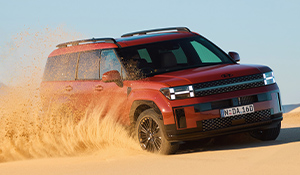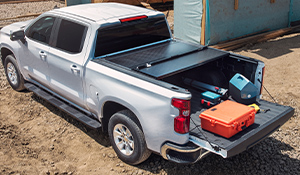4x4 Advice – How to drive on the beach
One of the greatest pleasures of owing a 4x4 is accessing and experiencing Australia’s out of the way places. Like me, many off-roaders favourite pursuit is driving along coastal shorelines. Whether it’s accessing pristine beaches with the family for a swim or getting to a prime beach fishing spot, beach driving can be a whole lot of fun, but it needs appropriate preparation and driving techniques to ensure a trouble-free trip.
Here are our top 5 tips:

Permits & Planning
Not all, but many beaches require a permit to drive on. Check with local councils and search their websites for accessibility and how to apply. Often these charges are nominal and accompanied with maps outlining hints, beach access points and any restricted areas. Accessibility can also vary depending on the time of year or after environmental impacts such as tides or storms. It’s also a great opportunity to check if it’s dog friendly if you’re taking your pooch along.
Secluded 4WD and dog friendly beach, with Port Macquarie in the distance.

Preparation
Before embarking on your beach journey-
- Ensure your vehicle is up to the task – ploughing through soft sand places great stress on the transmission and cooling systems in particular;
- Consider undertaking a 4WD training course, some of which specialise in beach driving. It will be too late when the tide is coming in;
- Recovery gear - Whether you’re on your own or not as a minimum, carry at least long handled shovel, snatch strap, dampener, 2 rated bow shackles and leather gloves. Ensure your 4WD has proper recovery points front and rear;
- A set of traction boards such as Maxtrax offers great peace of mind. With traction boards, I tie on a one metre hi-viz strap, so it’s easily unearthed as often it will get buried during a recovery;
- Carry a tyre pressure gauge and a quality air compressor – you will need to reduce air pressure and then re-inflate tyres;
- Keep your weight down but ensure you carry adequate fuel as usage will rise dramatically traversing through sand. It can easily double or more;
- Keeping in previous wheel tracks helps performance but avoid driving above the high tide mark; and
- Check the tides. Some beaches are impassable at or near high tides.

Local Knowledge
Whether you’re familiar with the area or not, it’s essential to research your chosen beach. Local 4x4 and fishing tackle stores are a great starting point but nothing beats questioning other drivers. I’ve never had an issue asking fellow drivers for information on driving a particular beach. Some things to ask are: what tyre pressure do they recommend (see below); conditions; access point; and what areas to drive and which to avoid. Finally, take a walk along the access route to see for yourself. Pick the line you think is best and ensure it is clear of debris or other vehicles.

The Drive
Before and after embarking:
Familiarise yourself with your vehicle’s 4WD selection procedures and traction control options. Your vehicle’s user manual is a great source of information. With modern vehicles selecting the wrong modes will see the car really struggle.
Lower your tyre pressures. For most 4WDs a good start is around 18PSI*. This will increase the tyre’s footprint preventing them digging in, so you float on the soft sand. It’s the length of the contact patch not the sideways bulge of the tyre that matters. Think of it as percentage changes rather than PSI numbers. Setting correct air pressures and proper tools is essential for beach driving.
*As mentioned, correct tyre deflation is your most advantageous and easiest asset when it comes to successful sand driving. Did you know that the tyre’s suitable deflation is influenced by many factors, such as the tyre’s make, construction, size and the weight of vehicle to name just a few…
If hauling a trailer, don’t assume necessary tyre pressures are similar all round.
Engage 4WD high range and lock the centre diff if equipped. Some people automatically stipulate to use low range for all sand but it’s not necessary for most beaches. It will come down to type of vehicle or if negotiating a difficult cutting, slow going or extremely soft sand, then low range may give you the edge. Cross-axle lockers are of little to no use in sand and may well just cause extra drag.
Disengage stability control where fitted, to prevent the vehicle’s electronics slowing momentum. If your 4WD is equipped with an adaptive terrain system such as Land Rover’s Terrain Response or Toyota’s Multi-Terrain Select, then choose the Sand option.

Select the correct gear and remember that momentum is your friend. Avoid changing gears in tough conditions such as ascents as momentum is quickly lost in sand.
If you feel the 4WD is struggling to keep pace, stop as soon as practical to avoid burying the tyres. Stop by just gently coming off the accelerator – the drag of the sand will slow you down. If you brake, you’ll dig in. Lowering tyre pressures in 10% increments will, 99% of the time be an easy fix. Remember that the lower the pressures the lower the speed and ensure your turns are smooth, else you risk peeling the tyre off the rim.
Avoid ploughing through the surf as salt water corrodes.
Use existing tyre tracks to your advantage where possible as the sand is compact and don’t fight the steering wheel, let the 4WD finds its own way through.
When you wish to stop. Choose a place that allows easy passage to other 4WDs and park pointing down the slope as it’s easier to depart.
Stick to the speed limit and use your indicator when approaching or overtaking other beach users.
Keep your headlights on, it’s hard to see an oncoming vehicle on a beach. At 60km/h you travel 1km in one minute. So, if another car is 1km away and doing 60km/h – barely visible - you’ll meet in 30 seconds.
Avoid dune destabilisation, always tread lightly and respect others and the environment.

At Days End
When it’s time to leave, check your exit point, use the correct gear and just enough momentum to get you out safely.
Remember to re-inflate your tyres to road pressures and take the earliest opportunity to give your 4WD a thorough wash to prevent salt corrosion, especially underneath.
Unlock your centre differential, and re-enable stability control.
Words by Steve Cassano
Photos by Arnold Archive









